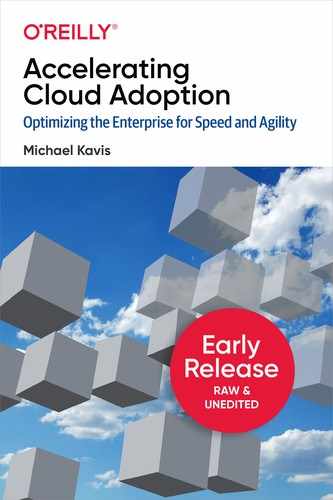Introduction
Why do we need a new operating model for cloud?
In 2006, Amazon launched Amazon Web Services (AWS) which provided compute, storage, and queuing services on demand, giving birth to the term cloud computing. While timesharing of computers had existing for decades, Amazon’s “software-defined everything” approach was groundbreaking. For the first time, enterprises could deploy software on virtual datacenters without ever having to purchase or lease physical infrastructure on-premises or at a hosted facility. In fact, they didn’t have to talk to a single human being. Enterprises could now run their software on Amazon’s datacenters and forgo the process of procuring, racking and stacking, and managing physical infrastructure.
We have all heard how developers flocked to the cloud because they were freed from long procurement cycles. AWS provided capabilities that allowed developers to self provision, manage, and change compute, network, and storage resources on demand from a self-service portal. Not only was the infrastructure self-service, it was scriptable—developers could now write code to provision infrastructure instead of relying on another group to procure, install, and alter hardware and its configurations. The result? Drastically reduced time to market. Almost overnight, the line between development (Dev) and Operations (Ops) started to see great synergies.
The term “shift left” refers to roles and responsibilities moving from downstream processes (e.g. testing or operations) and organizations to the development process and early planning phases. As domain areas like quality assurance (QA), security, networking, storage, and others start shifting left into the development organizations, existing organizational structures, roles, and responsibilities became disrupted. This disruption leads to a variety of challenges like political infighting, increased risk, legacy process bottlenecks, skill gap challenges, and much more. All of these challenges make cloud adoption extremely hard within large organizations and can lead to failed cloud adoption, poor return on investment (ROI), and soaring costs. Cloud adoption is fundamentally hard; big IT organizations are generally resistant to change given the risk-averse nature of most IT shops. We have seen many of our clients take on an odd strategy—adopt the cloud, but try to change as little as possible. As we will cover throughout the book, this approach has rarely led to the desired outcomes.
One of the fastest ways for a CIO to get fired is to lead an unsuccessful cloud transformation. Too often, cloud leaders focus a disproportionate amount of time and money on cloud technologies with little to no time and money focused on organizational change management and process reengineering. It takes investments in all three levers: people, process, and technology to succeed in the cloud. Transformation does not happen by buying a bunch of new tools. This book will focus on the people and process part of the equation, with the lens on cloud operations.
Throughout this book, we will discuss the common challenges that large organizations face when trying to operate in the cloud at scale. We will share our experiences from both as a practitioners who have built and operated born in the cloud companies, as IT leaders in Fortune 500 companies, and as long-time consultants with over 100 enterprise clients across the globe.
Before we get started, let’s clearly define what a cloud operating model is. An operating model is a visual representation of how an organization delivers value to its internal and external customers. A cloud operating model is a visual representation of how an organization delivers value from cloud services to its customers. The cloud operating model encompasses both organizational structure and a process flow model. A cloud operating model is a subset of an overall IT operating model.
Another term we will discuss throughout this book is cloud operations or CloudOps for short. In this book, CloudOps refers specifically to the people, process, and technology used to manage the operations of cloud software and cloud platforms. CloudOps focuses on operating production workloads in the cloud across any cloud service model: Infrastructure as a Service (IaaS), Platform as a Service (PaaS), and Software as a Service (SaaS).
What you should take away from this book is that building any old piece of software in the cloud is relatively easy, but building and operating software in the cloud at scale that is secure, compliant, highly available, and resilient is a very complex and challenging undertaking. If you expect (or your vendor is telling you) that by moving to the cloud these things become easy, you are in for a rude awakening. Traditional organizational structures and processes designed for deploying software on physical infrastructure in a datacenter do not translate well to the new world of cloud computing. This book will share best practices, anti-patterns, and lessons learned from over 10 years of experience and tons of battle scars.
Now let’s dive in!
